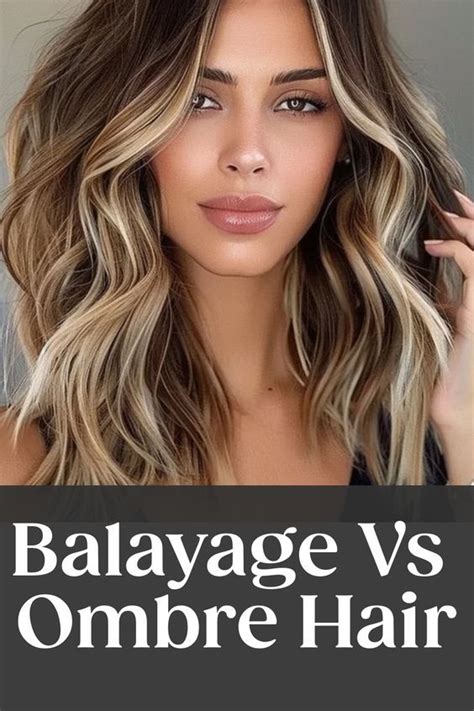Understanding Balayage
Balayage, a French term meaning “to sweep,” is a freehand hair painting technique that creates subtle, natural-looking highlights. Unlike traditional foil highlights, which use a cap or foil to separate hair sections, balayage involves applying bleach or color directly to the hair with a brush or sponge, creating a more graduated and blended effect.

Benefits of Balayage:
- Natural Look: Balayage mimics the natural sun-kissed highlights found on children’s hair, creating a flattering and effortlessly chic look.
- Low Maintenance: The subtle, blended nature of balayage means less frequent touch-ups are required compared to traditional highlights.
- Versatile: Balayage can be customized to suit various hair types, colors, and skin tones, making it a versatile option for a wide range of clients.
- Dimensional Effect: Balayage creates depth and dimension in the hair by adding lighter and darker tones, enhancing its overall appeal.
Understanding Ombre
Ombre, derived from the French word for “shade,” is a hair dyeing technique that creates a gradual blend from one color to another, typically from dark roots to lighter ends. Unlike balayage, ombre involves using color in larger sections, creating a more dramatic and noticeable transition.
Benefits of Ombre:
- Trendy and Fashionable: Ombre has become incredibly popular in recent years, offering a modern and stylish edge to the wearer’s look.
- Low Roots: Ombre allows for slower root growth, as it seamlessly blends into the hair’s natural color. This can be particularly beneficial for individuals who want to extend the time between salon visits.
- Versatile Effects: Ombre can be customized to create various effects, including subtle color melts or bold and vibrant transitions.
- Statement Look: Ombre creates a statement-making look that draws attention to the hair, making it suitable for individuals who prefer a more eye-catching style.
Balayage vs. Ombre: A Side-by-Side Comparison
| Feature | Balayage | Ombre |
|---|---|---|
| Technique | Freehand painting | Larger color sections |
| Result | Subtle, blended highlights | Gradual color transition |
| Maintenance | Low | Medium |
| Versatility | Customizable for various hair types | Suitable for all hair types |
| Appearance | Natural, effortless | Dramatic, eye-catching |
Deciding Between Balayage and Ombre: Key Considerations
Desired Look: Balayage is ideal for those seeking a softer, more natural-looking highlight effect, while ombre is better suited for individuals who prefer a bolder and more noticeable color transition.
Hair Type: Balayage works well on both fine and thick hair, while ombre may be more suitable for thicker hair types as it requires more color application.
Color Preferences: Balayage allows for a range of colors and tones, while ombre typically involves a transition between two contrasting shades.
Lifestyle: Balayage requires less maintenance and touch-ups, making it suitable for individuals with busy schedules. Ombre, on the other hand, requires more frequent color treatments to maintain its vibrancy.
Getting the Perfect Balayage or Ombre: Choosing a Stylist
Selecting an experienced and skilled hairstylist is crucial for achieving the desired balayage or ombre look. Here are some tips for finding the right stylist:
- Research and Consult: Read reviews, ask for recommendations, and consult with potential stylists to discuss your desired outcome and assess their technical skills.
- Examine Their Portfolio: Request a portfolio of the stylist’s previous work to gauge their expertise in balayage or ombre techniques.
- Consider Experience: Look for stylists with extensive experience in the specific technique you are seeking, as this ensures they have mastered the necessary skills.
- Communication and Trust: Find a stylist who listens attentively to your needs and understands your vision for the desired look. Establish clear communication to ensure your expectations are met.
Professional and Home Applications: Choosing the Right Method
Professional Application:
- Benefits: Ensures a precise application, even coverage, and professional-looking results.
- Cost: Varies depending on the salon, stylist, and complexity of the technique.
Home Application:
- Benefits: More economical and convenient, allows for flexibility in scheduling.
- Drawbacks: Requires basic skills and knowledge to avoid uneven application or color mishaps.
Care and Maintenance for Balayage and Ombre Hair
Regular Maintenance:
- Color Treatments: Touch-up appointments are recommended to maintain the vibrancy of the color and prevent fading.
- Home Care: Use sulfate-free shampoos and conditioners specifically designed for color-treated hair to preserve its integrity.
Other Care Tips:
- Protect From Heat Styling: Limit the use of heat styling tools to prevent damage and fading.
- Avoid Chlorine and Sun: Chlorine and UV rays can weaken and alter hair color, so protect it with appropriate products.
- Moisturize Regularly: Deep conditioning treatments and hair masks help replenish moisture and protect color-treated hair from becoming dry and brittle.
New Applications for Balayage and Ombre: Exploring Creative Boundaries
Balayage:
- Rainbow Balayage: A vibrant and playful variation that incorporates multiple colors into the hair, creating a unique and eye-catching look.
- Money Piece Balayage: Focuses on highlighting the hair around the face, framing it beautifully and adding brightness.
Ombre:
- Shadow Root Ombre: Creates a subtle transition from light ends to dark roots, enhancing depth and dimension.
- Reverse Ombre: Inverts the traditional ombre technique, starting with darker ends and gradually transitioning to lighter roots.
Conclusion
Balayage and ombre are two popular hair dyeing techniques that offer distinct looks and benefits. Understanding the differences between the two and their suitability for different hair types and desired outcomes is essential for making an informed decision. By choosing an experienced stylist, following proper care and maintenance practices, and exploring innovative applications, individuals can achieve the perfect balayage or ombre hair that meets their unique aesthetic preferences.
